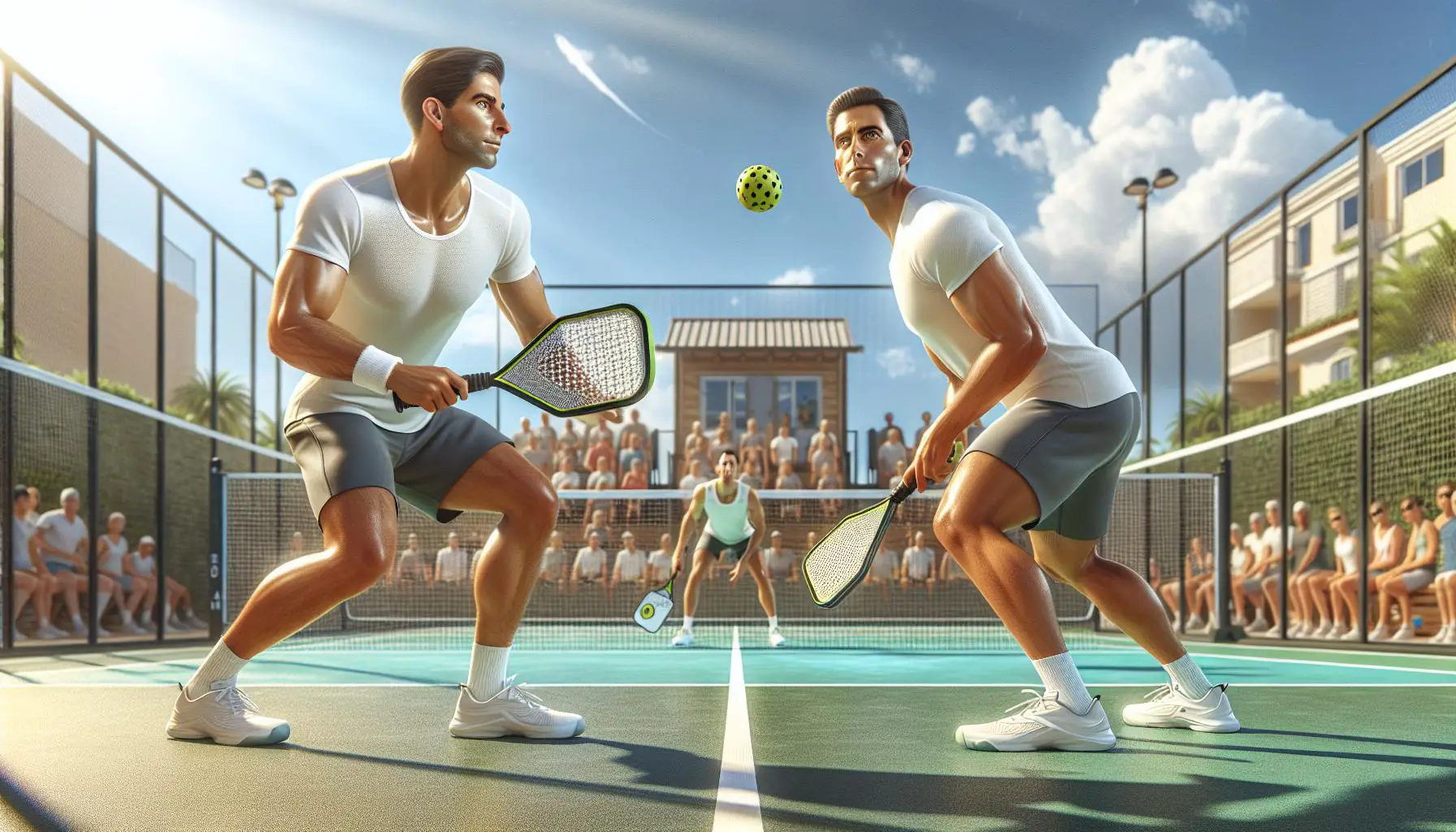Pickleball’s popularity is skyrocketing, and with it, the curiosity around its unique rules. Among these, the golden point rule stands out, intriguing beginners and seasoned players alike. It’s a game-changer, quite literally, that can turn the tide of any match.
But what exactly is the golden point rule, and why does it matter so much? It’s not just a quirky addition to the rulebook; it’s a strategic element that adds depth and excitement to the game. Let’s dive into the nitty-gritty of this rule and discover how it shapes the way pickleball is played.
What is the Golden Point Rule?
In pickleball, a sport that combines elements of tennis, badminton, and ping-pong, the Golden Point Rule stands out as a distinctive feature that adds a thrilling twist to the game. Unlike other rules that might seem straightforward, the Golden Point Rule introduces a strategic depth that can turn the tide of any match, making every point a potential game-changer.
At its core, the Golden Point Rule is invoked during a deuce in scoring, which occurs when both teams reach a score of 10. At this juncture, rather than playing until one team leads by two points, the next point won by either team is deemed the Golden Point. This crucial point then decides the winner of the game, adding a layer of suspense and excitement that’s unparalleled in other racket sports.
This rule not only speeds up the endgame but also puts immense pressure on both teams. They know that any minor slip could cost them the game. As a result, players often tweak their strategies and play styles to either capitalize on this rule or safeguard against it. They might play more conservatively to avoid mistakes or take calculated risks to snatch the golden opportunity from their opponents.
Strategic Importance Of The Golden Point
The introduction of the Golden Point has profound implications for the strategies employed by pickleball players. Teams or players that might be trailing have a fighting chance to clinch victory with just one well-played point. Conversely, leading players cannot rest on their laurels, as a sudden twist of fate could see their lead vanish. This rule ensures that games are more competitive and unpredictable, keeping both players and spectators on the edge of their seats.
Key Strategies Include:
- Aggressive Play: Some players choose to go on the offensive, believing that a strong, decisive move could win them the game.
- Defensive Tactics: Others might adopt a more defensive stance, trying to force their opponent into making a mistake.
- Mental Toughness: The pressure of the Golden Point demands strong mental resilience. Players need to stay calm and focused, making every move count.
How Does the Golden Point Rule Work?

In pickleball, the Golden Point Rule serves as a thrilling twist to the traditional scoring system, infusing the game with an extra layer of excitement and urgency. This unique rule comes into play when both teams reach a score of 10. At this juncture, instead of continuing in the typical manner where a team must win by two clear points, a single point—dubbed the Golden Point—determines the winner of the match. This dramatic shift not only speeds up the game’s conclusion but also significantly raises the stakes for the players involved.
Implementing the Golden Point requires both teams to recalibrate their strategies and mental preparation. As the game progresses towards this critical juncture, players often adjust their gameplay, switching from a perhaps conservative or standard approach to one that could either be highly aggressive or exceptionally defensive, depending on their strengths and assessment of the opponent’s weaknesses.
Under the pressure of the Golden Point, players’ abilities to maintain composure, execute precise shots, and read the opponent’s next move become more critical than ever. Each serve, volley, and return carries the weight of the entire match, making every decision and movement pivotal. The anticipation and buildup leading to this moment also test the players’ mental fortitude, as they must remain focused and avoid succumbing to the immense pressure of the Golden Point.
The atmosphere surrounding a Golden Point scenario is electric, with spectators and players alike feeling the intensity of the moment. The rule has transformed pickleball by ensuring that no lead is comfortable and that every point matters. It emphasizes not just skill and strategy but also the psychological resilience necessary to thrive under pressure.
Strategic Implications of the Golden Point Rule

When the Golden Point rule is in play, pickleball transcends its usual boundaries, turning a game of agility and skill into a psychological chess match. Teams must rethink their approach, recognizing that traditional tactics may not suffice when the stakes are at their highest. The Golden Point doesn’t just test physical prowess; it demands a mental acuity akin to playing several moves ahead in a high-stakes game.
Adaptability and Team Dynamics
In the heat of a Golden Point scenario, players’ ability to adapt becomes paramount. Teams that have previously relied on a powerful offense might find themselves switching gears, focusing on defense or employing deception to outwit their opponents. This pivot requires players to be versatile, switching roles fluidly and communicating effectively under pressure. Teams successful in navigating the Golden Point often display a remarkable level of synergy, where their movements and decisions on the court are perfectly synchronized.
Psychological Preparedness
The mental aspect of facing a Golden Point cannot be overstated. Players must cultivate a blend of focus and calmness, preparing themselves for a moment where every stroke is amplified. Mindfulness and visualization techniques become invaluable tools, empowering players to visualize success and remain cool under pressure. This mental resilience is what often separates the victors from the rest, showcasing the importance of psychological preparation in addition to physical training.
Tactical Innovation
The introduction of the Golden Point rule has ushered in an era of tactical innovation in pickleball. Coaches and players alike are devising new strategies to gain an edge during these high-pressure moments. Some of these tactics include:
- Targeted serving: Choosing serves that are more likely to put the receiving team in a defensive position right from the start.
- Selective aggression: Identifying moments to unleash powerful shots while maintaining control to avoid unforced errors.
- Positioning and court coverage: Adjusting positioning to cover the court more effectively, ready to counter the opponents’ attempts to find open spaces.
These innovations highlight the dynamic nature of pickleball strategy, which must continuously evolve to meet the challenges presented by pivotal rules like the Golden Point.
Examples of the Golden Point Rule in Action

Imagine a high-stakes pickleball tournament. The score is tied, and the game’s outcome hinges on a single, decisive point—the Golden Point. This is not just a hypothetical scenario; it happens in competitions around the world, turning games into nail-biting spectacles that showcase the rule’s impact.
In one notable tournament, a team found themselves at a crossroads during the final match. The score was 10-10, and tension filled the air as both teams prepared for the Golden Point. The serving team decided to employ a strategic serve they had been perfecting for such moments. This targeted serving technique caught their opponents off guard, allowing them to gain the advantage needed to win the point and ultimately the match. This example highlights how critical tactical innovation becomes under the Golden Point Rule.
Another instance occurred during a regional competition where a pair capitalized on selective aggression during their Golden Point. They had noticed their opponents’ defensive weakness towards the backhand side during regular play. When the Golden Point arrived, they executed a series of aggressive shots targeted at this weak spot. The strategy paid off, showcasing the importance of observation and strategic planning in pressure situations.
Teams often share stories of how improved court coverage has been their key to success in Golden Point scenarios. One duo, in particular, practiced a drill where they would cover as much of the court as possible, simulating high-pressure situations. Their hard work was put to the test in a match where the Golden Point was initiated due to a tie. Their ability to cover more ground and respond to their opponents’ shots more efficiently led them to victory, underlining the rule’s demand for physical readiness and strategic positioning.
Additionally, the psychological battle that unfolds during the Golden Point cannot be understated. A team once shared their approach to maintaining focus and calmness during such high-stakes moments. They employed mindfulness and visualization techniques leading up to and during the tournament. When faced with a Golden Point, they found themselves able to remain calm and focused, navigating the pressure better than their more anxious opponents. This mental fortitude turned out to be just as crucial as their physical skills.
| Strategy | Outcome |
|---|---|
| Targeted Serving | Won match with unexpected serve |
| Selective Aggression |
Conclusion
Mastering the Golden Point rule in pickleball isn’t just about honing physical skills—it’s a mental game too. As teams demonstrate through high-level play, incorporating strategic serving, aggression, and court coverage can significantly impact the game’s outcome. But it’s their mental toughness, through mindfulness and visualization, that often tips the scale in their favor. So whether you’re a seasoned player or new to the sport, embracing these strategies can elevate your game to new heights. Remember, it’s not just about the points you score but how strategically and calmly you play the game.














0 Comments